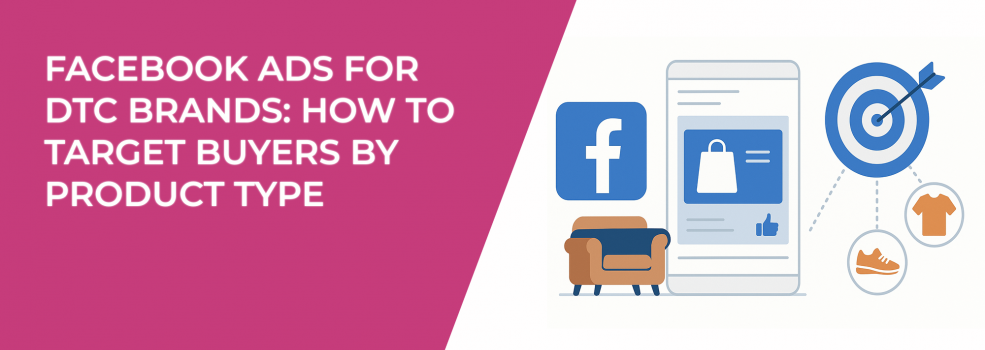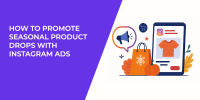Direct-to-consumer (DTC) brands live and die by how well they can reach the right buyers. Facebook Ads are often the fastest way to do it — but only if your targeting matches the kind of product you’re selling.
Different products attract different kinds of shoppers. A $20 gadget isn’t bought the same way as a $2,000 sofa. Treating them the same in your ad strategy is like showing everyone the same menu and hoping they order what you want.
Here’s how to target buyers more effectively by product type, with real tips you can use today.
Why Product Type Shapes Your Targeting
How people shop depends on what they’re buying.
-
Impulse buys are quick, emotional decisions.
-
High-ticket items take time, research, and trust.
-
Essentials require repeat reminders.
-
Luxury goods lean on exclusivity and status.
-
Niche products thrive in small, passionate communities.
If you’ve ever debated endlessly over one big purchase but bought a smaller item without thinking twice, you already know the difference. Your customers feel the same way.
And here’s the advantage many brands miss: with LeadEnforce, you can target people who follow specific Facebook groups, pages, or Instagram accounts. That means instead of just picking broad interests, you’re tapping into communities already passionate about your product category.
For a deeper dive on adjusting your strategy, check out Facebook Ads Targeting Updates: How To Adapt in 2025.
1. Impulse Buy Products
These are low-cost, easy-to-explain items that spark emotion. Think skincare masks, quirky kitchen tools, or phone cases.
How to target:
-
Keep it broad with lifestyle or hobby interests.
-
Use lookalikes from past buyers to expand reach.
-
Push for conversions quickly before the impulse fades.
With LeadEnforce: Selling beauty accessories? Target followers of popular makeup tutorial accounts on Instagram or skincare-focused Facebook groups. These audiences already act on “see it, want it” moments, making them perfect for impulse buys.
Related read: The Psychology of Facebook Ads: How to Hook Your Target Audience in Seconds.
2. High-Consideration Products
Furniture, electronics, fitness equipment — anything with a higher price tag. Buyers need reassurance, details, and trust before they click “Buy.”
How to target:
-
Start with interests tied to research (home design, fitness, tech enthusiasts).
-
Retarget visitors with reviews, case studies, or demos.
-
Use video ads to explain features and answer questions.
With LeadEnforce: A DTC office chair brand could target followers of coworking space pages or productivity accounts. These audiences already care about work setups, which makes them much more likely to spend time researching before investing in quality.
Want more ideas? See How to Target High-Ticket Buyers with Facebook Ads.
3. Everyday Essentials
Supplements, skincare, household goods — products people need over and over. The challenge is loyalty, not awareness.
How to target:
-
Build lookalikes from repeat buyers.
-
Layer purchase behavior signals.
-
Retarget with bundle or subscription offers.
With LeadEnforce: An eco-friendly cleaning brand could target followers of zero-waste and sustainability groups. These communities are already committed to eco-conscious living, which makes a subscription model (like auto-ship refills) more attractive.
Helpful resource: Facebook Ad Targeting for Repeat Purchases: Best Practices for 2025.
4. Luxury and Premium Products
Luxury buyers don’t purchase for utility alone. They buy for identity, lifestyle, and experience.
How to target:
-
Use narrow luxury-related interests (travel, designer fashion, fine art).
-
Exclude bargain-hunters to keep the audience refined.
-
Retarget with scarcity messages, elegant visuals, and exclusivity.
With LeadEnforce: A jewelry brand could target followers of luxury travel bloggers or high-end fashion accounts. Those audiences are already engaging with aspirational content, so your product naturally fits their world.
For inspiration, see Interest Stacking: A Powerful Method for Facebook Audience Segmentation.
5. Niche Products
These are for specific communities — gamers, climbers, hobbyists, or crafters. The buyers are already sold on the category. They just need the right brand.
How to target:
-
Go hyper-specific with interest targeting.
-
Build custom audiences from group engagement.
-
Retarget with user-generated content or case studies.
With LeadEnforce: A climbing gear brand could target followers of local climbing gyms, mountaineering clubs, or niche Instagram accounts showing real outdoor climbs. Instead of wasting spend on “outdoor enthusiasts,” you’re focusing directly on active climbers.
Wrapping It Up
Not all products should be advertised the same way on Facebook. Impulse buys thrive on speed. High-consideration items need trust. Essentials win with consistency. Luxury depends on exclusivity. Niche products shine inside communities.
The smartest DTC brands adapt their targeting to match how people shop. And with tools like LeadEnforce, you can go beyond broad interests and reach the exact groups, pages, and accounts where your future buyers are already hanging out.
That’s how you make Facebook Ads work harder, stretch your budget further, and connect with buyers who are ready to say yes.

